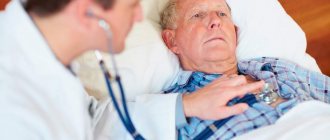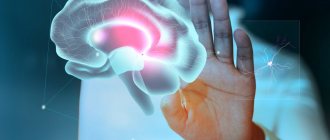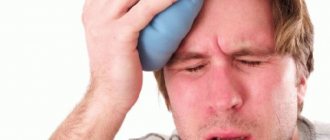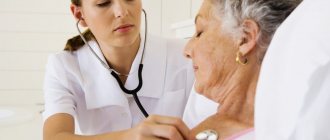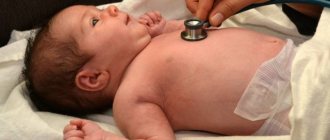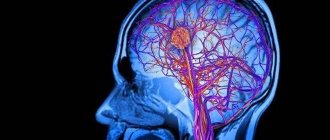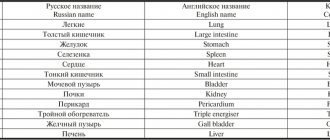Publication date: March 27, 2019
Stroke is a rapidly developing dysfunction of the central nervous system, which can be caused by hemorrhage (hemorrhagic form) or spasm or blockage of cerebral vessels (ischemic type). Recovery from a stroke on the right side is a fairly long process. Patients are strongly recommended to undergo rehabilitation in specialized centers under the supervision of qualified doctors.
Causes of brain stroke on the right
A right-sided stroke is different from a left-sided cerebral blood flow disorder because the functions of the two hemispheres are different. In the right - the centers that are responsible for sensitivity, motor skills, coordination are localized; with the help of the right hemisphere, a person understands words, uses hearing, touch, intuition, evaluates the surrounding space, perceives music, reads, writes, recognizes geometric shapes. In addition, the entire left side of the body is monitored and the information is analyzed together with data from the left hemisphere to completely solve any problem.
During a stroke, any of the listed functions are disrupted, and the trigger can be either an endogenous or an exogenous factor. The most dangerous:
- alcoholism, smoking, drugs;
- blood pressure surges, high ICP;
- binge eating;
- obesity;
- atherosclerosis;
- increased blood clotting;
- stress, psycho-emotional and physical stress;
- brain injuries;
- congenital pathologies;
- chronic somatic diseases of the heart and blood vessels;
- uncontrolled use of contraceptives.
Children with heart defects, genetic blood diseases, and endocrine disorders are at particular risk for right-sided stroke.
Etiopathogenesis
The main mechanism for the development of paralysis is stroke - damage to the artery with blood escaping beyond the vascular bed. As a result, a hematoma is formed, which gradually grows and compresses the brain tissue. Vital neurons die, loss of function is noted, control of skeletal and smooth muscles decreases, and sensitivity disappears.
This condition is predisposed to:
- Eating disorders – the main role is played by a lack of calcium in the diet, which strengthens the walls of the arteries. In these cases, cardiologists repeat “where it’s thin, that’s where it breaks.” Weakened brain vessels that are prone to damage can cause a stroke;
- Hypertension – the situation is aggravated by increased blood pressure, which can damage weakened blood vessels. In older people, there is a lack of calcium, which can cause artery rupture;
- Compounded heredity - according to recent studies, there is a predisposition to vascular diseases, especially hypertension and strokes. The mechanism has not been fully studied; insufficiency of the neurohumoral mechanism and weakness of the vascular wall are assumed;
- Obesity - this condition is accompanied by a lack of minerals, an increase in blood pressure, which increases the likelihood of developing a stroke with subsequent paralysis;
- Cardiovascular diseases - valve malformations, heart failure, atherosclerosis and thrombosis predispose to cerebral hemorrhage;
- Endocrine diseases - diabetes comes first, leading to hypertension and hemorrhages. Sometimes the causes are hypothyroidism, pathologies of the adrenal cortex;
- Bad habits - nicotine weakens the walls of arteries and increases cholesterol levels in the blood. Natural alcohol in minimal dosages is useful, but an excess of surrogate or drunkenness often ends in stroke and paralysis.
The listed factors can provoke both left and right paralysis. According to statistics, the latter option is observed more often, which increases the patient’s chances of survival due to timely diagnosis.
What is ischemic and hemorrhagic stroke
Based on etiology, right-sided stroke is divided into ischemic and hemorrhagic. The first develops due to impaired cerebral blood flow on the right due to narrowing of blood vessels or their complete blockage; the speed of blood movement and its viscosity also play a role. As a result, hypoxia of brain cells is provoked with their death and necrosis of a certain area of the brain. Symptoms of ischemic stroke increase gradually, so ischemia develops over several hours or even days, which makes it possible to consult a doctor in a timely manner and avoid fatal consequences. The prognosis for this form of the disease is affected only by the extent of the lesion (necrosis).
Hemorrhagic stroke is a hemorrhage in brain tissue due to rupture of blood vessels. Often this situation leads to cerebral edema, coma and death. Vascular rupture occurs much less frequently, but has more severe consequences, since there is no time to “build up”. The spilled blood permeates the tissues, compresses vital structures, sometimes completely destroying them. Regardless of the size of the affected area of the brain, nerve cells are restored slowly; not all lost functions of the nervous system can be restored.
Treatment
Thanks to the efforts of healthcare organizers, the system of stroke treatment in Russia has undergone positive changes. It has become the norm to transport patients with suspected cerebral circulatory disorders to an intensive care bed or neurosurgeon's table within three hours.
Treatment for stroke, when the right side is paralyzed, begins in the intensive care unit, where patients are hospitalized urgently. The treatment regimen provides for the normalization of blood circulation in the brain, restoration of respiratory and swallowing functions, and elimination of the threat of convulsive phenomena.
The treatment regimen for hemorrhagic stroke with paralysis of the right side is somewhat different. In this case, drugs that eliminate thromboembolism come to the fore. If treatment is started on time, the blood clot is destroyed and impaired blood flow is restored. Thanks to modern medications, it is often possible to completely avoid the consequences of a stroke.
The patient's condition requires normalization of homeostasis, a decrease in the degree of permeability of the vascular walls and the formation of plasmin. In some cases, blood clots from brain vessels are removed surgically in neurosurgery departments.
Consequences of ischemia
With a small area of necrosis of brain tissue or a micro-stroke on the right, the prognosis for the patient’s life is favorable: neurological changes are minimal and do not criminally impair brain function. An exception is trunk ischemia, since vital centers - respiratory and cardiovascular - are concentrated here. Therefore, even a microstroke of the brain stem almost 100% ends in death in the first hours.
The remaining patients will experience disability because, although they are not completely bedridden, they lose even a small ability to adequately, fully perceive the surrounding reality, understand what is happening to them, and the ability to think logically. For left-handed people it’s the other way around. For them, the consequences of a right-sided stroke are similar to ischemia of the left hemisphere in right-handed people.
The main consequences are presented in the table. We must understand that the consequences of ischemic stroke decrease over time with proper treatment. About a quarter of patients under 55 years of age recover fully from a microstroke without visible signs of any neurological impairment.
At the same time, no matter how many functions are rehabilitated in the first two years after a micro-stroke, so many will remain until the end of days. Nerve cells are practically not restored.
| Outcome of stroke on the right | Consequences of micro and macro ischemic stroke |
| Complete paralysis of the left side of the body | The movements of the left limbs are minimized, the position is half-bent, the patient is able to sit, but without assistance he is not able to walk or grasp objects with his hand (hemiplegia) |
| Imbalance of sensitivity on the left | Pain and temperature threshold increases (hypoesthesia) |
| Loss of sense of spatial arrangement of arms and legs | |
| Mental disorders | Criticism decreases, foolish behavior arises, speech becomes inadequate, the person becomes aggressive |
| Memory loss | Patients remember the past, but forget what they did an hour ago; temporary complete amnesia and disorientation in space and time are possible |
| Left vision disorders | Decreased vision up to blindness, double vision, turning the head and left eye to the left |
If the area of brain necrosis is large (massive stroke), the prognosis is disappointing: up to 70% of patients die in the first few days, others become deeply disabled. The consequences are:
- persistent paralysis: patients cannot even sit;
- cerebral coma;
- complete lack of criticism and thinking;
- swallowing disorders.
Symptoms
The signs of the onset of an illness are beyond doubt; not only doctors, but also ordinary people should know them in order to help their loved ones, acquaintances, or just a person on the street who has become ill in time. You should call the emergency room immediately if you experience the following symptoms:
- Sudden loss of speech (or when it becomes slurred);
- Inability to move an arm or leg;
- Inability to smile (the right side of the mouth sags);
- drooping eyelid;
- State of stupefaction, spatial and temporal disorientation, the patient complains of “mess in the head”;
- Severe headache with vomiting, dizziness;
- The extended right leg turns the foot inward;
- The right arm is bent and pressed towards the body.
What happens after a hemorrhage?
It makes sense to talk about the consequences of a hemorrhagic stroke only if we are talking about small hemorrhages on the right. Stroke-hematoma or large hemorrhage of the right hemisphere is almost 100% fatal.
No more than 10% of such patients can be saved by emergency removal of blood clots with drainage of the cranial cavity, but those who survive will remain deeply disabled for the rest of their days. Life expectancy is very short - from several days to several months.
With a small hemorrhage on the right, the prognosis is ambiguous: 75% survive, but become disabled, and the degree of disability is higher than with ischemia. Patients in 10% can fully recover, in 70% they are able to walk with difficulty, care for themselves, and are immobilized - up to 20%.
Differences in the consequences of hemorrhagic stroke of the right hemisphere:
- intolerance to loud sounds and bright light;
- increased irritability;
- cephalgia;
- lack of coordination;
- insomnia;
- swallowing disorder;
- hematoma in the ventricles of the brain.
In seriously ill patients after a stroke on the right side, regardless of the form, delayed complications occur: congestive pneumonia, bedsores, exhaustion due to great difficulties in caring for such patients. It is complications of this nature that cause the death of patients in the first two years of post-stroke life. About 15% live 10 years or more.
Diet
Diet is necessary to improve blood circulation and maintain immune resistance. A well-chosen table should contain everything necessary for the regeneration of damaged tissues, but not overload the weakened body.
The basic rules for the diet are as follows:
- exclusion of smoked and fatty foods;
- meat can only be eaten with the approval of a doctor, in small portions and pureed. The menu includes only lean varieties;
- enrich your diet with vegetables and fruits;
- exclude coffee, strong tea, soda and alcohol;
- food should be fractional, in small portions.
For seriously ill patients, the menu is prepared by a nutritionist, taking into account the state of the body and the necessary energy costs.
Features of therapy
Complex therapy for right-sided stroke is divided into correction of the acute period and rehabilitation. During the acute period, if there is a risk of severe consequences, surgical intervention may be required. The patient remains in the intensive care unit throughout the acute period. Treatment of right-sided stroke of any origin is carried out in several areas:
- basic: for ischemia - thrombolytics, disaggregants, anticoagulants (thrombolysis with a recombined type plasminogen activator is most effective), for hemorrhage - emergency hemostatic and vasoconstrictor agents;
- hypotensive: drugs that lower blood pressure relieve compression of nerves, remove tissue pastiness (Betalok, Stugeron, Triampur);
- normalizing cerebral blood flow: drugs with vasoactive and antiplatelet properties (Trental, Cavinton, Eufillin);
- neuroprotective: restore connections between neurons (Cellex);
- antioxidant: detoxify tissues, remove free radicals, renew cells (Vitamin E, C, Lycopene).
In the acute phase, it is important to control breathing, heart rate, and body temperature. Treatment is most effective during the first three, maximum five hours after the attack. Within a day, irreversible processes occur in neurons.
Massage
This method is aimed at preventing bedsores and is used from the first days of paralysis. The right side of the body is warmed up, after which blood circulation and tissue trophism are improved, and mobility in the joints is restored.
To eliminate the effects of paralysis, a standard warm-up includes:
- stroking - from the periphery, along the blood flow;
- rubbing – carried out more intensively, similar to the previous method;
- vibration movements – in the area of soft tissues;
- The procedure ends with stroking.
To prevent new bedsores from arising, it is recommended to massage daily, regularly change the patient’s position and rub the skin with alcohol (if there are no wounds).
Rehabilitation
The recovery period begins approximately a week after intensive therapy, it is developed by doctors of different specialties: rehabilitation specialists, neurologists, psychologists, physiotherapists, speech therapists, reflexologists, occupational therapists (specialists in the restoration of social, everyday, functional, motor skills), neurodefectologists.
There is a whole playlist on Youtube on this topic https://www.youtube.com/playlist?list=PLb9qc1uRvT8oorWN7lanTWl2BVkTJGm3v
The first stage is inpatient, the second is sanatorium, but the full course is carried out at home, which can last for several years. The set of measures includes: medications, exercise therapy, acupuncture, reflexology, physiotherapy, kinesiotherapy (exercise therapy based on oriental practices), massage, diet. The treatment regimen is strictly individual.
At home you need:
- eliminate all physical and psycho-emotional stress;
- balance the drinking and food diet with limiting lipoproteins;
- master a course of exercise therapy, including breathing;
- Constantly massage, especially in areas that have lost sensitivity;
- sanitize chronic foci of infection, somatic pathologies;
- eliminate all bad habits.
Particular attention to the prevention of bedsores, purulent corneal ulcers, hypostatic pneumonia, and contractures. To do this, special exercises are performed, the upper respiratory tract is cleaned, and if necessary, parenteral nutrition and bladder catheterization are provided.
The duration of rehabilitation can be only a month (for a mild form) or up to two or more years (for a severe form). Average rehabilitation is six months.
Prevention
- Primary prevention consists of proper nutrition, exercise, giving up bad habits and stress, adequate sleep and rest, and regular medical examinations.
- Secondary prevention of stroke includes the elimination of risk factors - treatment of concomitant pathologies, regular monitoring by the attending physician, elimination of risk factors. This approach will help not only prevent stroke, but also improve overall health. According to WHO estimates, the creation of an adequate system of care for patients with stroke will make it possible in the coming years to reduce mortality during the 1st month of the disease by 20% and ensure independence in everyday life 3 months after its onset in at least 70% of patients.
Forecast
Life expectancy after a stroke in the right hemisphere depends on many factors, which are listed in the table:
| What affects the consequences of a stroke and life expectancy | How exactly |
| Ischemia or hemorrhage at the heart of stroke | After an ischemic stroke, the chances of recovery are higher |
| Lesion size | The larger the area of brain tissue damage, the worse the prognosis |
| Involvement of vital brain centers in pathological changes | Brainstem stroke – fatal |
| Age, physical condition of the patient | In elderly and frail patients, the prognosis is a priori worse |
| Timeliness of medical care | If assistance is provided later than three to five hours after the impact, the consequences are irreversible |
How to treat
Treatment for ischemic stroke on the right side of the brain begins only after the diagnosis is confirmed. The doctor draws up an action plan based on the results of the examination.
Recognition methods
Diagnosis of right-sided ischemic stroke is quite simple. You need to ask the person to perform 3 actions: smile, raise both hands at the same time, say your name.
A person will not have a full smile, since the corner of the lips will be pulled down. One arm will be weaker than the other, as a result of which he will not be able to lift both of them up. He is not able to pronounce even a simple name.
If there are difficulties with at least 2 steps, you must immediately contact an ambulance. The doctor has just over 4 hours to save the victim.
The main thing is to see a doctor in time
The doctor who treats strokes is a neurologist. He takes part in the restoration of lost mental and physical functions. The main tasks of a specialist when working with patients who have already been discharged from the hospital are secondary prevention, which is aimed at preventing a recurrent attack, as well as drug treatment of the consequences of the “stroke”.
A modern method for diagnosing pathology is ultrasound duplex scanning of neck vessels. An image of the vessel is formed, its patency and structure are displayed. Diagnostics allows timely detection and prevention of vascular diseases, including stroke.
You need to undergo the study if:
- frequent fainting, headaches, dizziness;
- hypertension;
- arrhythmias;
- elevated cholesterol levels;
- traumatic brain injuries;
- sleep, vision and hearing disorders;
- weakened attention, memory loss.
The necessary studies are prescribed by a neurologist. Based on diagnostic data, treatment is prescribed, which varies depending on the type of stroke.
Our clinic address: St. Petersburg, st. Bolshaya Raznochinnaya, 27 metro station Chkalovskaya
Visit to a speech therapist
To restore speech, daily training is required, which will be supervised by a specialist. The patient is given homework, including systematic exercises.
The objectives of such therapy are:
- restoration of oral speech;
- rehabilitation of writing;
- normalization of speech memory.
It is very important that a person not only learns to speak, but also understands the speech of others. Experts recommend that patients not isolate themselves, but constantly contact people.


